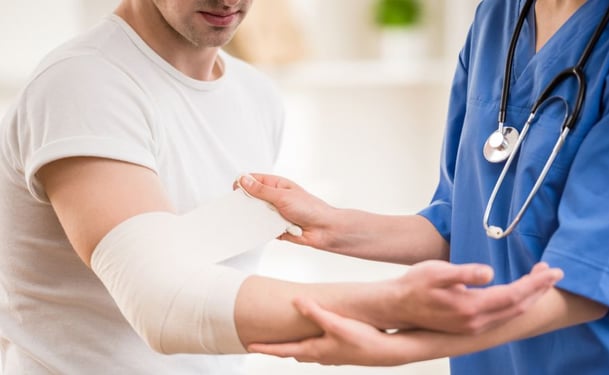A partial thickness burn (also known as a second degree burn) is a burn that affects the top two layers of skin, called the epidermis and hypodermis. Partial thickness burns can continue to change over time and can evolve to a full thickness burn (or third degree burn), even after initial treatment. Partial thickness burns are serious and have a high risk of developing infection or other complications.
Causes of Second Degree Burns
Partial thickness burns can be caused by heat, friction, electricity, light, radiation or chemicals. According to the American Burn Association, the majority of burns are a direct result of fire or flame, followed by scalds.
Types of Second Degree Burns
In addition to depth, all burns are classified by severity, such as major, moderate and minor, based upon a number of factors:
- Age of patient
- Depth of burn
- Total body surface area affected by the burn
- Location of the burn
- Coexisting injuries or illnesses
Generally, partial thickness burns are placed into two categories: superficial partial thickness burns and deep partial thickness burns. The depth of a burn can be difficult to determine and should be evaluated by a health care professional. Distinguishing between superficial and deep partial thickness burns is important because the former may spontaneously heal on its own, while the latter is likely to require surgical treatment.
Signs and Symptoms
Superficial partial thickness burns extend superficially into the second layer of skin. Symptoms include:
- Red skin that blanches (turns white) when pressure is applied (such as when pressing a finger on the skin)
- Clear blisters (open or closed) are present
- The skin is moist and painful
Deep partial thickness burns extend deeply into the second layer of skin and can quickly evolve into a full thickness (or third degree) burn. Symptoms include:
- Red and white skin that does not blanch readily
- Bloody blisters are present
- The skin is moist and painful
Who Is at Risk
Children are at great risk for burns, as are individuals in high-risk job categories such as:
- Jobs that involve working around heat, flames or sparks
- Professionals working with electrical equipment
- Individuals working with chemicals, combustibles or radioactive material
Treatment Options for Second Degree Burns
Partial thickness burns are serious and should be treated by a health care professional immediately. First aid that can be administered prior to medical treatment includes:
- Move away from the source of the burn and remove any clothing from around the burn
- Flush the partial thickness burn with cool water for approximately 15 minutes and pat dry with a clean cloth
- Do not open any blisters that may form
- Do not use ice to cool the burn
- Soak a clean cloth with cool water, wring out excess water, fold and apply to burn as a compress (to help relieve pain)
- Bandage the burn with a nonstick bandage or sterile cloth to protect from bacteria and foreign debris
- Have the burn evaluated by a health care professional the same day
A health care professional can evaluate the proper bandage needed and if further treatment is required. Depending on the location and size of the burn, additional treatments may include:
- Medicines to treat pain, swelling and fever
- Anti-itch medications
- Antibiotic therapy
- Debridement (cleaning or removing dirt, dead tissue or objects from the wound)
- Skin grafting (a patch of healthy skin is transferred from one part of the body to the burn wound to improve healing)
- Escharotomy (a cut made along dead tissue to decrease swelling)
- Specialized bandages
- IV fluid therapy
- Specialized blood tests
Prevention
Safety measures in the home and on the job are important steps to preventing burns. The following actions can help prevent burn injuries:
- Wearing protective equipment around chemicals, flames and fire
- Never leave open flame unattended
- Never leave children unattended in the home
- Teach children about the dangers of fire, hot water, electricity and chemicals
- Do not use fire, chemicals or perform electrical work while under the influence of drugs or alcohol
- Immediately treat a burn once it has occurred to prevent worsening or further complications


